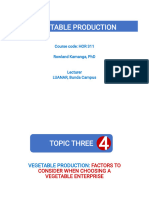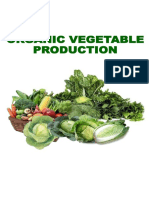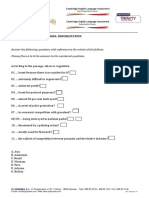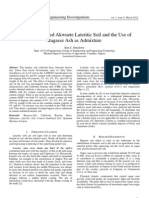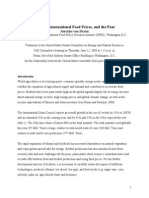0 ratings0% found this document useful (0 votes)
15 viewsCHPT 4 PDF Slide
CHPT 4 PDF Slide
Uploaded by
alemumelsChap
Copyright:
© All Rights Reserved
Available Formats
Download as PDF, TXT or read online from Scribd
CHPT 4 PDF Slide
CHPT 4 PDF Slide
Uploaded by
alemumels0 ratings0% found this document useful (0 votes)
15 views23 pagesChap
Original Title
chpt 4 pdf slide
Copyright
© © All Rights Reserved
Available Formats
PDF, TXT or read online from Scribd
Share this document
Did you find this document useful?
Is this content inappropriate?
Chap
Copyright:
© All Rights Reserved
Available Formats
Download as PDF, TXT or read online from Scribd
Download as pdf or txt
0 ratings0% found this document useful (0 votes)
15 views23 pagesCHPT 4 PDF Slide
CHPT 4 PDF Slide
Uploaded by
alemumelsChap
Copyright:
© All Rights Reserved
Available Formats
Download as PDF, TXT or read online from Scribd
Download as pdf or txt
You are on page 1of 23
Chapter 4
Cropping system and Agronomic/cultural Practices
Introduction
of crops
• The art and science of crop production is a dynamic process.
• Improvements in methods of planting, cultivation, soil and
water conservation and management, harvesting, storage and
marketing;
• New techniques for weed, insect pests and disease control
• The formulation of better fertilizer as well as improvements in
their efficient use are the main agronomic practices improved
through a time by doing research
4.1. Site selection
Criteria of site selection
• Suitability of soil, (its fertility, texture, pH, depth….)
• Site must have proper drainage and no water stagnation
during rainy season
• There must be proper transport facilities either by road or
rail within the reach.
• Suitable climatic conditions,
• site is free from cyclone, frost, hailstorms and strong hot
winds.
• Availability of labor
• Wind break plants
4.2 Land Preparation
• Tillage is changing a soil’s condition or position with a tool.
• Tillage is a mechanical string of soil for seedbed
preparation for planting.
• It includes cutting and inversion of hard soils and separates
it from lower layers after the harvest of previous crop or
fallow land.
• Purpose of tillage: - in general, tillage is carried out for one
or a combination of the following reasons.
a. Seedbed preparation/breaking crusts:- Tillage loosens the
soil, and results in a seedbed suitable for seed germination
and the development of young seedlings.
Cont…
b. Control of weeds and insect pests
• Tillage kills weeds cutting them just below ground level
• Tillage also initiates the germination of many weed seeds
that will be destroyed by subsequent cultivation.
• Tillage exposes the eggs and larvae of insect pests to
adverse conditions such as sun and predators, and destroys
their breeding grounds.
• There is a similar effect on underground rodents.
Cont…
c. Improving nutritional status of the soil
• Tillage incorporates organic matter and crop residue into
the soil.
• Once mixed in the soil, they are able to decay more
rapidly so that their residual nutrients can be made
available to the growing plant.
d. Soil and water conservation
• Improving soil moisture regime
• Improving infiltration
• Contour tillage can aid in erosion control
Cont…
e. Improvement of the soil’s physical condition
• Soil aeration, structure & texture improvement through
breaking of soil crusts
f. Improving soil sanitation
• By incorporating crop residues, weeds, volunteer plants in
to soil
g. Preparation of land for surface irrigation
h. Improving moisture regime: - reducing surface run-off
thereafter improve infiltration and may double the amount of
water stored in soil
Types of tillage
i. Traditional tillage – using oxen drawn plough, hoe culture
ii. Conventional tillage – tractor plough followed by harrowing
iii. Conservation tillage – at least 30% of the soil remains covered
by crop residue after sowing. This includes:
Stubble mulch farming - retaining crop residues on the soil
surface
Minimum tillage –reducing tillage to the minimum necessary for
ensuring
a good seedbed,
rapid germination,
a satisfactory stand, and favorable growing conditions.
No tillage (also called zero tillage)
4.3 Sowing and Planting the Crop
• Field crops are established either from seeds or from some
vegetative plant parts
• Sowing is used for seeds, whereas planting for vegetative
plant parts.
Time of sowing/planting:- Several factors influence time of
sowing/planting.
• These include: Rainfall ,
Temperature,
Day length,
Occurrence of diseases and pests,
Availability of labor and equipment, Marketing, Cropping
systems
Cont…
Rate of sowing
• Rate of sowing depends on the expected percentage of
the seed and the number of plants desired per stand.
Spacing between stands
• The spacing between stands is largely determined by the
extent of the root and shoot systems of the crop plant in
question.
Depth of sowing :- The depth at which the seed is placed
in the soil is influenced by:
• Seed size – the larger the seed, the greater the depth
from which it can emerge and the deeper it can be safely
sown.
Cont…
• Moisture status of the soil – under dry condition seeds
should be sown deeper in order to place them in contact
with moist soil.
• Soil type – all other factors being equal, seeds can emerge
from greater depths in sandy soils than in clay soils.
Method of sowing:
• Broad casting: sowing is done by scattering the seeds at
random on the field.
• Drilling: seeds are sown in continuous band in rows.
4.4. Fertilizer application
• Manure/fertilizers:– encompass all the substances added
to the soil in order to increase the supply of plant
nutrients.
• This could be both organic and inorganic.
• Formulation of fertilizers – fertilizers are available in either
of the following
• Solid/dry
• Gas
• Liquid/fluid
No Organic fertilizer Inorganic fertilizer
1 Mostly dissolves slowly in Mostly dissolves quickly in the
the soil solution soil solution
2 Slowly utilized by plants Rapidly utilized by plants
3 Contains low concentration Contains high concentration of
of nutrients nutrients
4 It is formed from locally Mostly commercial fertilizers
available materials
5 Required as large Required in small quantities, in
quantities, in terms of rates terms of rates
Evenly application in the soil
Apply near the plant root
Covering the fertilizer with the soil after application
Apply fertilizer at appropriate time and growth stage
(before, during and after planting)
Apply irrigation after fertilizer application
Application and management of fertilizers
• The four best management practices, commonly referred to as the
4Rs or four ‘rights’ of fertilizer management are to apply
– the right source of nutrient
– the right rate,
– the right time and
– in the right place to meet crop demand.
• The right fertilizer product means matching the fertilizer source
and product to the crop’s needs and the properties of the soil.
Cont…
• Fertilizers should be applied when the plant needs them (i.e.
before/at planting, flowering, fruiting)
• How do we apply fertilizers?
• Broadcasting – the fertilizer is spread over the entire soil area to be
fertilized
• Top dressing – applying fertilizers in standing crops
• Side dressing – apply fertilizers between the rows or around the
plants
• Band placement – application of fertilizers into the soil close to the
seed/plant and is employed when relatively small quantities of
fertilizers
• Foliar application – spraying of the leaves of growing plants with
suitable fertilizer solutions.
• Fertigation:- Application through irrigation water –which are easily
soluble in water.
3.6. Crop Protection
4.1 Weeds
• Definitions
weed as a plant growing where it is not desired, or a plant out of
place.
• Weed Management Methods
a. Prevention Methods
b. Curative Methods
• Cultural methods or cropping methods and competitive methods
• Several cultural practices like tillage, planting, fertilizer application,
irrigation etc., are employed for creating favorable condition for the
crop.
• Field preparation
• Summer tillage/Dry season
• Optimum plant population
Cont…
• Crop rotation
• Growing of intercrops
• Mulching
• Solarisation- using of solar energy for the desiccation of weeds
C. Mechanical methods
• Tillage
• Hoeing
• Hand pulling/hand weeding
• Digging
• Chiseling
d. Eradication Measures
e. Biological methods:- use of living organisms to suppress
f. Bioherbicides:- It is the use of plant pathogen
g. Chemical methods
4.5. Disease & insect control
4.5.1 Insect Pests
• Definitions- pest is to include any organism that is detrimental to a
crop. Effect of insect pests includes:
• Reduction in yield (reduce plant population, diverting nutrients from
the crop, destroying the marketable product)
• Reduction in quality (blemished, discolored, light weight products
with off flavors
• Increase in production cost
• Transmit disease causing organisms
Options for insect pest control
• Regulatory methods – quarantine, phytosanitory
• Physical methods – nets and bags
• Mechanical methods – removal and killing of insect pests
• Cultural methods – timeliness operations, trap cropping, crop
rotation, inter-cropping
• Host plant resistance
• Biological control – use of parasites and predators
• Sex pheromones
• Insecticides
• Integrated pest management – judicious selection and use of
compatible control options to keep pest populations below
damaging level.
4.5.2. Diseases
• Definition – plant that showed any deviation from normal
functioning of physiological processes said to be diseased plant.
• Classification of plant diseases based on:
• Causal agents of diseases – fungi, bacteria, nematodes, viruses
• Their occurrence on the plant – localized and systemic
• Where the causal agent occur – soil, seed and air borne
• The symptom they cause – root rot, wilts, smuts
• Parts of plants affected – root, stem, fruit diseases
Cont…
• Control measures for plant diseases
• Exclusion – the pathogen and the host should kept away each other
• Eradication of pathogens – eliminates, destroy or make inactive the
inoculum
• Immunization - development of resistant host
• Chemical control
• Integrated control of plant diseases
4.6. Harvesting
• For successful and efficient harvesting of a crop, it is desirable to
know:
• When to harvest
• How to harvest
• How to minimize loss during harvest
• When to harvest (maturity of the crop)
• For food crops, maturity refers to the stage of development at which
a crop is most desirable to the consumer
Maturity symptoms for some crops
• Wheat: - yellowing of spikelets
• Barley: - loss of green colour from glumes/peduncle
• Maize: - black layer in the placental regions of the grain
• Sorghum: - yellow colored ears with hard grains
• F.millet: - brown colored ears with hard grains
• Tef: - yellowish of the vegetative part
• Pulses: - brown colored pods with hard seeds inside pods
• Groundnut: - pods turn dark from light color, on pressing the kernels, oil is
observed on fingers
• How to harvest :- Generally they are two types of harvesting
Hand harvesting
Mechanical harvesting
You might also like
- Cropping System RevisedDocument15 pagesCropping System Revisedricellelupos25No ratings yet
- PRODUCE ORGANIC VEGETABLES PhilDocument38 pagesPRODUCE ORGANIC VEGETABLES PhilAlvin Jay Castillo100% (3)
- Robert Burns' To A MouseDocument2 pagesRobert Burns' To A MouseDonoghue100% (8)
- Soil ManagementDocument90 pagesSoil ManagementGwendie Kaye Rigor-GallardeNo ratings yet
- UC2 - Produce Organic VegetablesDocument42 pagesUC2 - Produce Organic VegetablesButch Demayo100% (1)
- Organic Vegetable ProductionDocument45 pagesOrganic Vegetable ProductionDiether Garcia100% (2)
- Agronomic PracticesDocument38 pagesAgronomic PracticesAbdikadir M. AlaaleNo ratings yet
- Feild Crop MGTDocument17 pagesFeild Crop MGTdebebedegu81No ratings yet
- 5.0. Factors To Consider When Choosing VegDocument30 pages5.0. Factors To Consider When Choosing VegletuschiphuphuNo ratings yet
- Transplanting of SeedlingsDocument20 pagesTransplanting of SeedlingsMarycon NacitoNo ratings yet
- 10 Vegetable ProductionDocument16 pages10 Vegetable ProductionMcangels bandaNo ratings yet
- Chapter 5Document33 pagesChapter 5Nezif MohammedNo ratings yet
- Weed PPT SlidesDocument20 pagesWeed PPT Slideskblawan03No ratings yet
- Epp Agriculture-1Document17 pagesEpp Agriculture-1Ryan Jeffrey FabilaneNo ratings yet
- UNIT 4 4.14.2 Group 5 AGRICULTURE - ORTIZ - MONTAÑEZDocument41 pagesUNIT 4 4.14.2 Group 5 AGRICULTURE - ORTIZ - MONTAÑEZBwbsjjsiwijebdbd BwnzimissunzwNo ratings yet
- Perform Plant Care and ManagementDocument26 pagesPerform Plant Care and ManagementRegie MacayaNo ratings yet
- Crop Care and MaintenanceDocument68 pagesCrop Care and MaintenanceZoila EscalonaNo ratings yet
- Maintain The Growth of Vegetable CropsDocument40 pagesMaintain The Growth of Vegetable CropsOwell Angeles FababierNo ratings yet
- LO3 Perform Plant Care and ManagementDocument26 pagesLO3 Perform Plant Care and ManagementRegie MacayaNo ratings yet
- l1 Crop Production Grade VIII Vidyadaan - 1594888139930Document46 pagesl1 Crop Production Grade VIII Vidyadaan - 1594888139930Kailash NayakNo ratings yet
- Care and MaIntenance of Crops 2Document68 pagesCare and MaIntenance of Crops 2Zoila EscalonaNo ratings yet
- Lecture 5 Fundementals of Fert ApplicaticationDocument41 pagesLecture 5 Fundementals of Fert Applicaticationmoizqaiser78No ratings yet
- Produce Organic Vegetable-1Document39 pagesProduce Organic Vegetable-1baitan dadiganNo ratings yet
- Acp Nc1 ModuleDocument161 pagesAcp Nc1 ModuleNina ResplandorNo ratings yet
- Agronomy Crop Production (CH)Document45 pagesAgronomy Crop Production (CH)Parvathi M L100% (1)
- Organic Control of Pests and DiseasesDocument82 pagesOrganic Control of Pests and DiseasesSchool Vegetable GardeningNo ratings yet
- Cropping PatternsDocument35 pagesCropping PatternsAlyster BalingitNo ratings yet
- Organic Vegetable ProductionDocument12 pagesOrganic Vegetable Productionjeffrey sarolNo ratings yet
- Chapter 15 Agricultural Methods and Pest ManagementDocument40 pagesChapter 15 Agricultural Methods and Pest ManagementVAIBHAV100% (1)
- SQUASH PRODUCTION Seminar ADocument21 pagesSQUASH PRODUCTION Seminar AKylaa Angelica de LeonNo ratings yet
- Growing MediaDocument19 pagesGrowing MediaRonald CortezanoNo ratings yet
- Technology: Development of Agriculture and Its Great DilemmasDocument7 pagesTechnology: Development of Agriculture and Its Great DilemmasAngeli Kathleen SottoNo ratings yet
- Crop MorphologyDocument108 pagesCrop MorphologyRyan Calderon0% (1)
- Chapter 6Document29 pagesChapter 6Muhammad FikriNo ratings yet
- 2024 Chapter 1 NotesDocument6 pages2024 Chapter 1 NotesXAVIER'S CMI PUBLIC SCHOOLNo ratings yet
- Lesson 4 CULTURAL PRACTICES IN CROP OPERATION AT101Document6 pagesLesson 4 CULTURAL PRACTICES IN CROP OPERATION AT101Gerardo AgunatNo ratings yet
- ORGANIC Vegetables1Document94 pagesORGANIC Vegetables1Justin Benedict Cobacha MacutoNo ratings yet
- Crop Production ComponentDocument83 pagesCrop Production ComponentMa.charlina LozadaNo ratings yet
- Agri6 Intro To OrganicDocument27 pagesAgri6 Intro To OrganicMark Dave BallenasNo ratings yet
- Chapter 12 Improvement in Food ResourcesDocument32 pagesChapter 12 Improvement in Food ResourcesSrinibash JenaNo ratings yet
- Chap10 Foodsoil and PesticidesDocument57 pagesChap10 Foodsoil and Pesticidesjnjbz21 desturaNo ratings yet
- Chapter 3 - Cropping SystemsDocument35 pagesChapter 3 - Cropping SystemsAbdi KhadarNo ratings yet
- Note For CRP 302 2022.2023Document37 pagesNote For CRP 302 2022.2023sophiavanessa011No ratings yet
- Maize ProductionDocument24 pagesMaize Productionjack oumaNo ratings yet
- IPMDocument24 pagesIPMNihar ParmarNo ratings yet
- Organic Vegetable Production2Document33 pagesOrganic Vegetable Production2Francis Leo LoberanesNo ratings yet
- Carry-Out Harvest and OperationsDocument68 pagesCarry-Out Harvest and OperationsManilyn GaranganaoNo ratings yet
- CropsDocument22 pagesCropsMarife CulabaNo ratings yet
- Crop Rotation - CSP ProjectDocument22 pagesCrop Rotation - CSP Projectrifathmuzammilshaik24100% (1)
- Lesson 4 Crop Care and MaintenanceDocument37 pagesLesson 4 Crop Care and MaintenancelukerhettlunaNo ratings yet
- Improvement in Food Resources Part 01Document67 pagesImprovement in Food Resources Part 01Purvi Prakash KNo ratings yet
- BL354CDocument14 pagesBL354Calhaji mayutaNo ratings yet
- Notes 3Document16 pagesNotes 3wwaweru210No ratings yet
- Lecture 1 Establishment of GardenDocument55 pagesLecture 1 Establishment of Gardenasadalijanjua.0003No ratings yet
- Nursery Operation and ManagementDocument24 pagesNursery Operation and Managementyan100% (1)
- Crop RotationDocument6 pagesCrop RotationJames KinuthiaNo ratings yet
- CS 222 Presentation New Curricula 2020Document178 pagesCS 222 Presentation New Curricula 2020danielNo ratings yet
- Crop Production and ManagementDocument22 pagesCrop Production and ManagementRichard PintoNo ratings yet
- 5 Care and Maintain CropsDocument24 pages5 Care and Maintain Cropsmarcos tadlanNo ratings yet
- Farm Tool, Implements and Equipment IdentificationDocument28 pagesFarm Tool, Implements and Equipment IdentificationalingNo ratings yet
- This Maharashtra Farmer's Co-Operative Has Proved To Be A Boon For The Small Farmer - HuffPost IndiaDocument6 pagesThis Maharashtra Farmer's Co-Operative Has Proved To Be A Boon For The Small Farmer - HuffPost Indiamailsk123No ratings yet
- CAE Reading DeforestationDocument4 pagesCAE Reading DeforestationMarijana SmolčecNo ratings yet
- Cassava - Preparations and Basic RecipesDocument7 pagesCassava - Preparations and Basic RecipesBarbaraNo ratings yet
- Cambridge IGCSE: AGRICULTURE 0600/12Document24 pagesCambridge IGCSE: AGRICULTURE 0600/12For GamingNo ratings yet
- Cropping System of BiharDocument3 pagesCropping System of Biharfo5611.bgpNo ratings yet
- Jennifer Bissell Clips Daily1Document6 pagesJennifer Bissell Clips Daily1api-231411574No ratings yet
- Poster MulchinDocument1 pagePoster Mulchinamit nigamNo ratings yet
- Contract of Lease - HaciendaDocument5 pagesContract of Lease - HaciendaaceamulongNo ratings yet
- Isabgol UsesDocument15 pagesIsabgol UsesMuhammad IqbalNo ratings yet
- Slope ProtectionDocument2 pagesSlope ProtectionAlexandru CîrcuNo ratings yet
- Rural DevelopmentDocument10 pagesRural DevelopmentshareevNo ratings yet
- Natural Resources: Prepared By, Mr. Snehal Patel Assistant Professor, Sumandeep Vidyapeeth, Vadodara, Gujarat, IndiaDocument52 pagesNatural Resources: Prepared By, Mr. Snehal Patel Assistant Professor, Sumandeep Vidyapeeth, Vadodara, Gujarat, IndiaJagesh RanjanNo ratings yet
- Salient Features of Indus Basin Barrages of Pakistan and Its Off Taking CanalsDocument19 pagesSalient Features of Indus Basin Barrages of Pakistan and Its Off Taking CanalsHAFIZ ARSALAN ALINo ratings yet
- Cement Stabilized Akwuete Lateritic Soil and The Use of Bagasse Ash As AdmixtureDocument5 pagesCement Stabilized Akwuete Lateritic Soil and The Use of Bagasse Ash As AdmixtureInternational Journal of Science and Engineering Investigations100% (1)
- Agricultural Extension - The Nature and Importance of AgricultureDocument7 pagesAgricultural Extension - The Nature and Importance of AgricultureOliver TalipNo ratings yet
- Quantifying Soil Erosion and Sediment Yield in A Catchment in Southern Brazil and Implications For Land ConservationDocument14 pagesQuantifying Soil Erosion and Sediment Yield in A Catchment in Southern Brazil and Implications For Land ConservationMax SteelNo ratings yet
- Biofuels, International Food Prices, and The Poor: Joachim Von BraunDocument7 pagesBiofuels, International Food Prices, and The Poor: Joachim Von BraunJunaid MalikNo ratings yet
- The Accounts of Othere and WulfstanDocument4 pagesThe Accounts of Othere and WulfstanBEATRIZNo ratings yet
- Kempe Gowda I - WikipediaDocument5 pagesKempe Gowda I - Wikipediamdu59714No ratings yet
- IntoductionDocument5 pagesIntoductionShahnawaz ZardariNo ratings yet
- 10 Myths About World HungerDocument1 page10 Myths About World HungerJaniss PrinceNo ratings yet
- Survey of Weeds On Tea Camellia Sinensis L Kuntze Plantations On The Mambilla Plateau in NigeriaDocument5 pagesSurvey of Weeds On Tea Camellia Sinensis L Kuntze Plantations On The Mambilla Plateau in NigeriaMuhammad SalehNo ratings yet
- Cropping Pattern of PakistanDocument7 pagesCropping Pattern of PakistanAtif RahmanNo ratings yet
- Internship ReportDocument45 pagesInternship ReportOsman RashidNo ratings yet
- Cross On 1994Document15 pagesCross On 1994Anushrut MNo ratings yet
- Three Orders .Document13 pagesThree Orders .anushkagoel4321No ratings yet
- School of Graduate Studies Haramaya University: College: Agriculture and Environmental SciencesDocument8 pagesSchool of Graduate Studies Haramaya University: College: Agriculture and Environmental SciencesKumera Dinkisa Tolera100% (1)
- Investment Opportunities in Africa & Project Book in AfricaDocument24 pagesInvestment Opportunities in Africa & Project Book in Africamokrane sabriNo ratings yet








